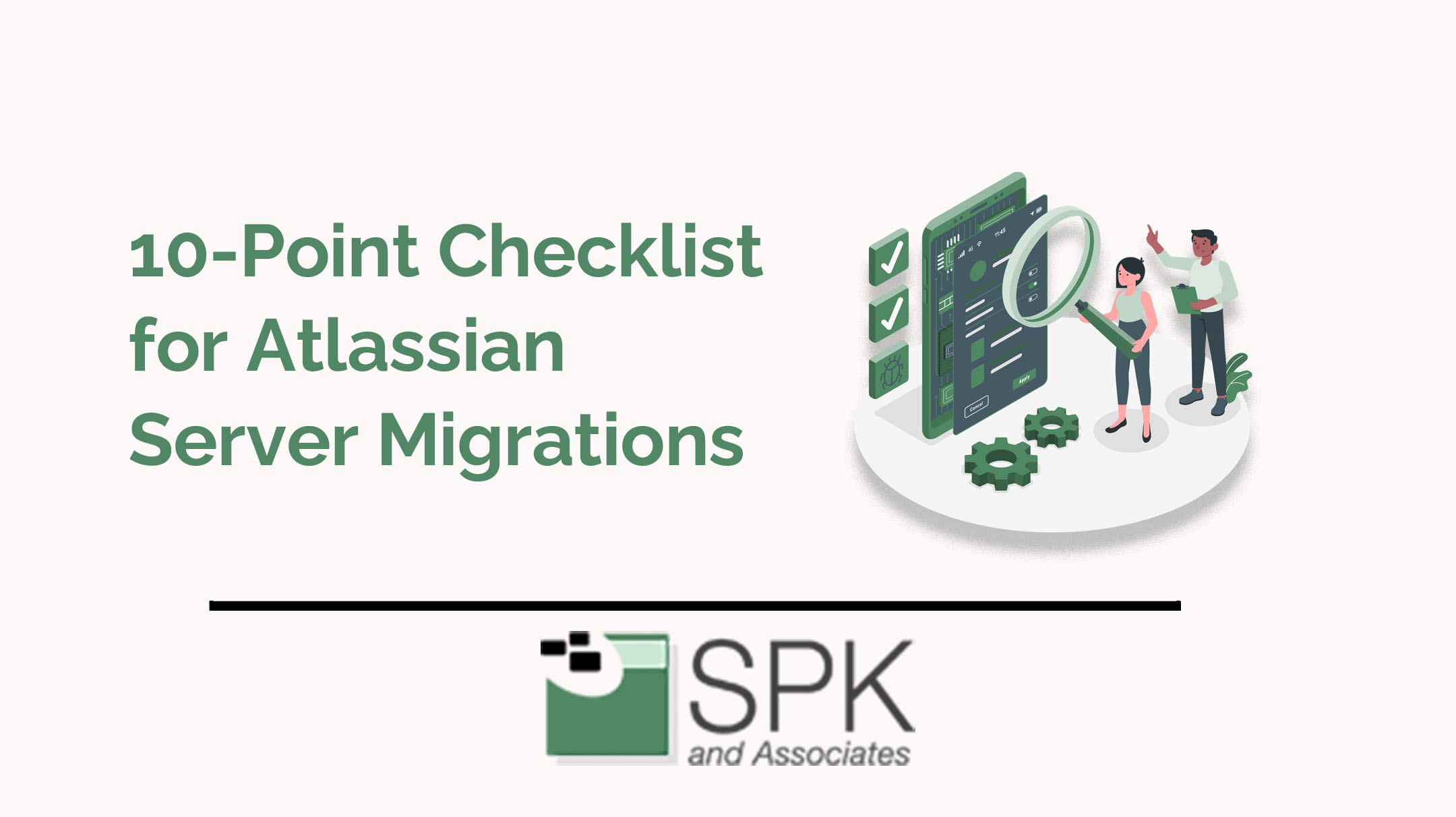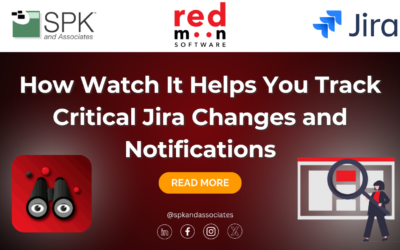Introduction
As applications, such as Jira, become more mainstream for Enterprises, it was inevitable that Atlassian and others would create their own service (SaaS) that provides numerous benefits to users across the globe. The benefits of having a SaaS solution for something like Jira are, potentially, huge. Things like operations and maintenance are removed from organizations having to determine the right time to do upgrades or fix issues with the application’s infrastructure. Now, the SaaS provider is responsible for this, which potentially lowers the TCO for a SaaS or “Cloud” application.
This checklist gives specifics on how Atlassian migrations from their “Server” product to either Atlassian Cloud or their Data Center version can be reviewed and added into your Atlassian journey.
Let’s provide some context on why this checklist exists. When Atlassian was originally founded, it was founded as more of a “team-level”, or “grass roots” type of company providing great software to help teams get work done. It was not targeting Enterprises directly. The applications they created, starting with Jira in 2002, were configured to be installed on a single server/workstation. Back in those days, team leaders were fine with installing Jira or Confluence on a workstation that they also did their coding work on (eek! Crazy, right?). As teams began to use Jira and rely on it more and more, the application needed to be more robust. Not only from a feature set perspective, but also the application needed to be configured in order to sit on multiple servers (physical or virtual) and configured for failover. By this time, Jira had become a huge part of the ALM market and Enterprises were using and paying for Atlassian licensing but most never knew how prevalent and important the Atlassian applications were to their overall productivity. They required a solution with the ability to have redundancies that ensured work didn’t stop.
Fast-forward a few years, and Atlassian came to the realization that their on-prem solution was in need of an upgrade/change. This upgrade/change factored in a SaaS platform, Atlassian Cloud, as the future of their service offering. While the early days of Atlassian Cloud were a struggle, the platform in 2021 is as solid as any other out there and has several benefits that Enterprises can take advantage of. But it’s not for everyone.
Thus, SPK and Associates has created this 10-Point Checklist for Atlassian Server Migrations. This document will help organizations that are trying to move from Server to either Atlassian Cloud or just move to the on-premise options for Data Center. Let’s dive in.
Check 1: Confirm Existing Licensing
The first step in going anywhere is to figure out where you are. In this case, what Atlassian licenses do you currently have? A simple way to do this is to work directly with Atlassian (if you purchased them directly through Atlassian) or via an Atlassian partner. It sounds very simple, but many Atlassian customers do not know what they are paying for. Part of the confusion with this is related to what Atlassian Marketplace applications (3rd party add-ons) that you may have paid for. Because you pay Atlassian for these Marketplace add-ons, and may see it as part of the system you paid for, these can sometimes be missed. For any migration to be successful, you need to know what you have and how that’s being used today. Some questions to ask…
- What version of Atlassian products are we licensed for?
- How many users are we licensed for?
- How many users are active in our system?
- What Marketplace add-ons are we licensed for? Of those, what ones are we using? Who is the stakeholder for those add-ons?
Check 2: Confirm Current Environment Statistics
For this check, we will want to look at the current Atlassian environment(s). This normally means you’ll need administrative level access to either the server(s) in question and/or application level administrative access. For Server or Data Center versions, any application administrative user can see all files and have full database access. This differs from Cloud, and these items may not apply directly for Cloud to Cloud migrations.
You’ll want to gather these pieces of information, as they may shape future checks and steps.
- What version of the Atlassian Software are we using?
- How many projects are in Jira?
- How many spaces are in Confluence?
- How many pages are in Confluence?
- How many projects are in Bitbucket?
- How many pipelines are in Bitbucket?
- How many code repositories are in Bitbucket?
- How many issues are in Jira/JSM?
- What is the size of all attachments?
- What is the current operating system for the front end?
- What is the source database type?
- What integrations do you currently have configured?
- What customizations or automations have been installed/configured?
Check 3: Select an Atlassian Partner
While this may sound self-serving, hear us out. Not every Server to Cloud or Server to Data Center migration will need an Atlassian partner’s assistance. However, Atlassian is focused on providing the best possible software and platform. Each Atlassian customer’s experience is different and their needs are different. Thus, Atlassian themselves may not be able to provide the right level of guidance, recommendation and implementation support as an Atlassian Partner can.
Atlassian themselves says of their partners… “Our trusted Atlassian Partners offer a wide range of accredited services, apps and integrations, training, and customized solutions to extend the power of Atlassian products.”
Because some of these migrations can be very complicated, Atlassian solution partners are skilled and equipped to help enterprises migrate to the right platform that fits their needs.
Atlassian Partners have different specializations and experience. You can find Atlassian Partners here: https://partnerdirectory.atlassian.com/
Check 4: Validate Compliance Needs
Each enterprise has different compliance, security, technical and organizational level requirements. Because of this, it is best that your teams or an Atlassian partner help you with the research to confirm what platforms fit your requirements.
In short, Atlassian’s Cloud platform is still in its evolution. It is not a “final-never-changing product”. Keep in mind that Atlassian Cloud is a multi-tenant platform. This complicates some requirements for compliance. Atlassian has been very transparent about what compliance requirements they have completed, and which ones are still in the roadmap. You can view the Atlassian Cloud Roadmap here: https://www.atlassian.com/roadmap/cloud
You can see all compliance category related roadmap information here:
https://www.atlassian.com/roadmap/cloud?category=compliance&
If you have a compliance need that Atlassian Cloud isn’t currently accomplishing, and the timeline that Atlassian has provided does not fit with your need to migrate off of the Server product, you can look at the Data Center version. This will give your Atlassian applications a home until such time that the Atlassian Cloud does address your compliance requirements and you can look at a migration to Atlassian Cloud at that time.
Check 5: Review Data Center and Cloud Plans
Based upon the previous check, you are probably now to the point where you’re trying to determine what is right for you? Should you go to the Atlassian Cloud or migrate to the Data Center version of your Atlassian products. Knowing what Data Center pricing and Cloud plans are available and what features you’ll get with each is your next step.
Below are a few good links that will give you information related to Data Center costs and Cloud plans available with the features for each. Keep in mind that Data Center costs will just be for licensing, while Cloud plans include both licensing and hosting (maintenance, operations, infrastructure). So the costs are not 1:1, which we will talk more about in upcoming checks.
Atlassian Cloud Calculator: https://www.atlassian.com/software/pricing-calculator
Atlassian Jira Cloud Plan breakdown: https://support.atlassian.com/jira-cloud-administration/docs/explore-jira-cloud-plans/
Compare Atlassian Cloud and Data Center: https://www.atlassian.com/migration/assess/compare-cloud-data-center
Check 6: Determine User Limit Needs for Scalability
Along with the Atlassian Journey to Cloud announcement, which discussed the end of Server support in February 2024, it also talked about changes to Cloud and Data Center pricing. While Atlassian did include Loyalty Discounts for those on Server or Data Center to move to Data Center or Cloud, the user tiers did change for Data Center and there is a huge delta between the user tiers available for Server and what is available now for Data Center. Thus, you should review what you have, and what is available for you to migrate to. In many instances, unless you’re going to Atlassian Cloud and paying on a credit card monthly, it will not be 1 to 1.
For example, if you are looking to migrate to Atlassian Cloud and looking to pay on a monthly basis, Atlassian will bill you for the max amount of users you have in a month. For example, if you add and remove a few users during the month but your maximum number of users for the month is 132 in Jira, then you’ll be billed for 132 users. However, if you want to migrate to Atlassian Cloud and are looking to pay on a yearly basis, you will be billed at the 200 user level, not the actual number of users. Atlassian does this because they want to provide clients with the ability to grow at a small amount without having to pay again. However, this means that depending on how many active users you anticipate, it may deter you from paying yearly to get any type of discount. This is because the discount may be wiped out by the increase to the next hundred user tier. Thus, with the example above, you’ll want to ask stakeholders what their growth plans are in the coming 12 months.
Check 7: Review Existing Infrastructure Costs
If you are currently hosting a Server or Data Center version of Atlassian products, you know that there are infrastructure costs. In many cases, the organization doesn’t calculate these very frequently and the true infrastructure cost will be subjective. However, you have the ability to calculate these costs and ensure your total cost of ownership for on-prem solutions or Atlassian Cloud can be shown and reported on.
Atlassian has published a Cloud ROI calculator that gives some good research and examples on how you can determine your existing costs related to infrastructure.
Check 8: Review Existing Maintenance and Operations Costs
Much like the Infrastructure costs, Atlassian maintenance and operations costs are also things that need to be determined to ensure the right decision is made before the migration. Maintenance costs will include planning and execution of upgrades and patches to the system, administration of the system such as user additions, removals, etc.
Another item to consider from a maintenance and operational cost perspective is Capital Expenditures (CapEx) and Operational Expenditures (OpEx). Atlassian’s ROI and TCO Calculator has a great statement to ensure you’re categorizing these costs correctly.
“Capital Expenditures (CapEx) are assets purchased for long-term benefits that remain on an organization’s balance sheet and depreciate over time (such as servers, upkeep, and insurance tied to asset use).
Operational Expenditures (OpEx) are expenses associated with purchasing services for a pre-determined period of time or pay-as-you-go (such as cloud and SaaS products, which usually include all costs required to run the software).
OpEx costs, such as cloud services, tend to offer organizations more flexibility in both the short and long-term. The pay-as-you-go model allows organizations to scale as they grow—rather than making a large up-front bet on future-year needs. When investing in CapEx, such as servers, the accounting team must account for how to amortize the assets as they depreciate over time and plan ahead for when the next large purchase will be required.”
Check 9: Determine Product Integration Needs
One potentially painful portion to any Server migration will be the availability of product add-ons. The Atlassian Marketplace is full of roughly 3,000 applications that are available for Data Center versions of their products, while there are over 1,000 apps for Atlassian Cloud. The likelihood of there being the exact same add on in either Data Center or Atlassian Cloud that you have today in your Server environment is high, but not 100%. Thus, you will want to audit each Marketplace add-on to confirm there is a version for your destination.
In some instances, there is not a version available for your destination platform and this is where Atlassian Partners can provide a huge help. Solution Partners like SPK and Associates have the ability to determine the right workflows, data points, and integrations needed to either find alternative add-ons, or create custom add-ons to fit your business need. This specific check can hinder migration timelines and forces many internal discussions with stakeholders to determine what alternatives are acceptable.
Check 10: Confirm Availability of Discounts for Licensing
In October 2020, when Atlassian made its announcement for the end of support for their Server products, they also created a financial incentive for clients to migrate to cloud… and soon. Atlassian called these discounts “Loyalty Discounts” to their existing Server or Data Center user base. These discounts were tiered, with the highest discount coming if you purchase Data Center or Atlassian Cloud soon after the announcement.
The chart below provides some explanation of the discounts available for Jira/Confluence/JSM as of the time of this publication for current Atlassian license holders.
| Discount Name | Discount Available On/After 7/1/2021 | Discount Available on/After 7/1/2022 |
| Data Center Loyalty Discount | 15% – Up to 1,000 users 30% – 1,001+ users | 0% |
| Cloud Loyalty Discount | 0% – Up to 1,000 users 40% – 1,001+ users | 0% |
Because there are time drivers to these discounts, you will not want to wait to determine what discounts you’ll get and when those discounts will go away. That means quotes will need to be time stamped before the dates above in order to get the discounts offered by Atlassian under this Loyalty Discount program. The discounts above are specifically for Atlassian products, not Marketplace vendor add-ons. Some Atlassian Partners have the ability to obtain discounts for Markeplace vendor add-ons but you should check that in advance before doing final calculations. Because these discounts and dates can be very complex, it is recommended to work with an Atlassian Partner to help you through the discounts available.
Conclusion
Migrating an existing website is a tough task. Migrating a complex application like Atlassian’s suite of products is even harder, and doing it to a slightly different platform can be extremely difficult. SPK and Associates does a lot of research and awareness when performing client migrations if we want the best outcomes. With this checklist, we hope that we have covered the basic tips that will help you with your Server migrations.
You might be interested in more detailed information about Atlassian Cloud and Data Center, and choosing between the two. We have a webinar available that will walk you through the choices in more detail.






